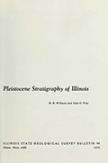Historical:Grayslake Peat
Lithostratigraphy: Grayslake Peat
Chronostratigraphy: Cenozoic Erathem >>Quaternary System >>Holocene Series
Authors
H. B. Willman and John C. Frye
Name origin
The Grayslake Peat is named for exposures of peat in the pit of the Grayslake Peat Company 1 mile southeast of Grayslake, Lake County, NE SE NE Sec. 2, T. 44 N., R. 10 E.
Type section
The type section (Hester and Lamar, 1969, p. 12) exposes 14 feet of peat. It is here classified as a formation.
Extent and thickness
The Grayslake Peat occurs most abundantly in lake basins in the northern part of the Valparaiso Drift in McHenry and Lake Counties, but it is present in nearly all counties in the area of Woodfordian glaciation. It also is present in some filled or partially filled floodplain lakes, particularly along the Illinois Valley below Starved Rock, and in abandoned channels resulting from glacial diversion, such as the Goose Lake Channel in Whiteside County. In these areas it locally overlies the Cahokia Alluvium.
The deposits vary greatly in thickness and some 30 feet thick have been reported. The most detailed maps of the peat deposits are in county reports of the University of Illinois Agricultural Experiment Station. Some of the peat deposits shown on early maps have been drained and, as a result of oxidation, are greatly thinned and changed into organic silts. Some would not now be classified as peat.
Lithology
It consists for the most part of organic deposits that are covered only by soil or slopewash from surrounding hills. The formation is largely peat and muck, but locally it is partly or largely marl. Many deposits contain interbedded silt and clay.
Age and correlation
The Grayslake Peat is Wisconsinan and Holocene in age.
Environment of deposition
The Grayslake Peat develops in a swampy depression or in the late stage of lake filling. It overlies lacustrine sediments, outwash, or till. It underlies the flat surfaces of the lake basins and, in places, borders present lakes. Many of the areas are swampy and the deposits still accumulating.
References
HESTER, N. C, and J. E. LAMAR, 1969, Peat and humus in Illinois: Illinois State Geological Survey Industrial Minerals Notes 37, 14 p.
ISGS Codes
| Stratigraphic Code | Geo Unit Designation |
|---|---|
